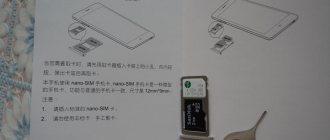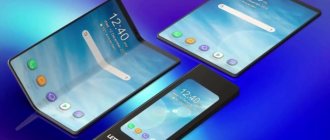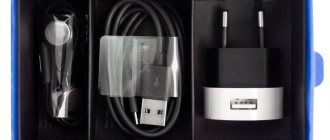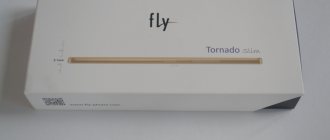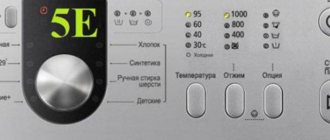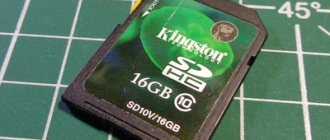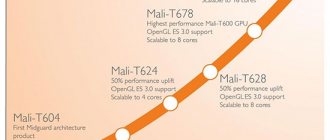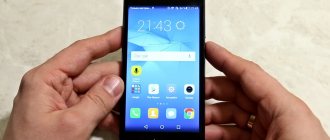Huawei marketers have divided the company's smartphones into four series: Y ( y outh - young), G ( g old - gold), P ( platinum - platinum) and D ( diamond - diamond). It’s easy to guess that the first two classes include entry-level and mid-level devices, and the D series includes technically advanced flagships. Huawei's “platinum” smartphones (to which, accordingly, Ascend P6 belongs) stand apart, since, on the one hand, they are equipped with quite good technical components, with which it is not a shame to pretend to be the main device of the company, and on the other hand, they have very pleasant appearance. It’s not for nothing that the press release of the tested gadget began with the words: “Introducing Ascend P6: Huawei’s new designer flagship - the thinnest smartphone in the world.” Therefore, despite the fact that the device does not belong to the company’s highest D-class, it is also considered a flagship, and not just a simple one, but a designer one.
⇡#Appearance and ergonomics
You can have a long discussion on the topic “whether or not the race for better performance figures is advisable.” If we talk about the dimensions of the smartphone, LG engineers, for example, believe that it is better for the device to be a millimeter thicker, but it will accommodate a more capacious battery. There is certainly logic in such judgments, but one thing cannot be denied: thin smartphones look really cool.
Huawei Ascend P6 - front panel
The body of the device is made almost entirely of aluminum, which ensures sufficient structural strength. The gadget withstood the compression of the sides without creaking a single part, and there were no characteristic color stains on the screen either. The build quality is very high. At the same time, the device weighs relatively little - 120 grams.
Huawei Ascend P6 front view
The only plastic element in the entire case is a rounded insert at the bottom. It slightly spoils the appearance of the smartphone - without it the gadget would look more harmonious.
Huawei Ascend P6 with screen on
As befits a device running the fourth version of Android, there are no physical keys on the front panel, so its main area is occupied by the screen. The thickness of the frame around the display on the sides is kept to a minimum - it does not even reach two millimeters. At the top of the panel there is a slot for the earpiece and the front camera lens.
Huawei Ascend P6 - general view
When you first get acquainted with the device, your eyes involuntarily notice numerous nuances in which it is similar to Apple smartphones of the fourth and fifth generations. The most noticeable of all are the sides of the case, made of aluminum with characteristic “seams” at the top. In this case, it is absolutely possible to answer the question of what device Huawei designers were inspired by. On the right side of the case there are power keys, volume control keys, as well as connectors for MicroSD and micro-SIM, which, like in the same smartphone, are opened using a needle key.
Huawei Ascend P6 - back panel and sides
However, Huawei engineers did not hide the needle in a bag of documents, but combined it with a plug for the audio jack. They probably hoped that it would be harder to lose her this way. However, the Ascend P6 arrived to us without the ill-fated needle - it seems that one of those who tested the smartphone before us was still able to sow it. The micro-USB interface, from which the device is charged, is located at the top end. Next to it is one of the microphones, the second is hidden on the bottom edge.
Huawei Ascend P6 - rear panel
The back of the device is textured but smooth, which can make the device slip out of your hands. In its upper part there is a lens of the main 8-megapixel camera and a flash, in the lower part there is a slot for an external speaker. Not a single element protrudes from the case, so the declared thickness of 6.2 mm can be considered absolutely fair. The back cover of the Huawei Ascend P6 is non-removable, which eliminates the possibility of hot-swapping the battery.
Review and tests of Huawei Ascend P6S. Elegant Android smartphone
Huawei smartphones undoubtedly stand out noticeably from their competitors, and this primarily concerns the Ascend P line. Models in this line have always been focused on image, here the performance race was secondary. Last year we already tested Huawei Ascend P6 and attended the Russian presentation of Huawei Ascend P7. While the new flagship has not yet reached the editors, we have the opportunity to look at the new reincarnation of the previous generation in the face of Huawei Ascend P6S. Another feature of Ascend P was the thinness of the case, which was a record at the time of its release. And even now the number of models with a thickness of less than 6.5 mm can be listed from memory. The emphasis on design and original design is justified; now it’s difficult to surprise with anything in terms of filling; there is a lot of identical hardware on the shelves with different logos on the body. Processor manufacturers are also not standing still; everyday tasks and games are now possible with basic SoCs. And what is left for those who want to have a fashionable smartphone, but are not ready to overpay for top-end hardware?
Video review of Huawei Ascend P6S
Availability of Huawei Ascend P6S
At the time of testing, the average cost of Huawei Ascend P6S, according to the Yandex.Market service, is 17,900 rubles.
Appearance
There are several body color options to choose from. From classic black to “cute” pink. You can choose according to your taste.
Huawei Ascend P6S looks very stylish and harmonious. The design is completely inherited from Ascend P6. As before, there are sharp edges, a non-separable body, a glass-covered front part, a rounded bottom edge, thin thickness and metal.
But let me make a reservation right away: the metal here has noticeably decreased in volume. It is preserved on the side edge, with a wide rim made of polished aluminum. But the lid became plastic. Personally, I'm not a big fan of the all-metal body, but it's on the edge that metal is a good material, it's pleasant to the touch and improves the strength of the structure.
The bottom edge of the smartphone smoothly transitions into the back cover. This part is also plastic. There is a Huawei logo on the front. The smartphone does not have touch buttons; they are moved to the interface.
The front part is covered with protective glass. It is scratch resistant. At the top there is a speaker grille and a front camera peephole.
Speaking of dimensions, and here they are 132.6 x 65.5 x 6.2 mm with a weight of 120 g, it fits well in the hands, and they are quite comfortable working with the fingers of one hand.
The design uses high-quality plastic. The material is non-staining and has a light textured pattern.
The back cover is not removable. It is flat, there are no protrusions, all elements are made without protruding parts. At the top there is a camera eye and an LED flash. At the bottom there is a small speaker grille. It overlaps when placed in the palm. Huawei Ascend P6S has both mechanical buttons on the right side. On top is the power button, below is the volume rocker. They are made in the same style with the side edge.
Below are two compartments for SIM cards. To access them you will need a special key, which can be replaced by a needle. Here it also serves as a plug for the audio jack.
If you use the audio jack frequently, we recommend leaving the key at home as it can easily be lost. The audio jack itself is located at the bottom. Not the most optimal location; connecting headphones in your pocket will be more difficult than with the classic location.
Another connector is located on the top edge, this is microUSB. Next to it you can see the hole of the noise-canceling microphone. There are no complaints about the build quality and materials.
Screen
Huawei Ascend P6S has a 4.7-inch IPS display with a resolution of 1280×720 pixels. Pixel density 312 ppi. The display recognizes touches with gloves and is highly sensitive. An anti-glare filter and oleophobic coating are provided. There is no air gap between the protective glass and the matrix.
The screen has a high reserve of maximum brightness. It is comfortable to work with a smartphone even in direct sunlight. The brightness can be adjusted automatically. It is also worth noting the wide viewing angles without distortion of brightness and shades. The illumination is uniform. The color balance is shifted towards cool tones.
Filling
Huawei Ascend P6S is built on its own HiSilicon V9R1 platform. It is a quad-core processor with ARM Cortex-A9 cores and clocked at 1.6 GHz. Mali-450 graphics are responsible for the video. This filling has become more powerful than that of Ascend P6.
On board there are 2 GB of RAM and 16 GB of data storage. Of this memory, approximately 12 GB are available upon first startup. It is worth understanding that there is no support for microSD memory cards.
Media
Despite the compact speaker, the smartphone demonstrates good sound. The sound is clear and smooth over a wide frequency range. There is a volume reserve. Supports FM radio, voice recorder and player.
Connection
Work in 3G networks is supported; unfortunately, work with LTE has not been added. In addition, there is Wi-Fi, Wi-Fi Direct, Bluetooth 3.0. Navigation comes with the combined use of GPS and GLONASS. It takes less than 30 seconds to find satellites.
Working with two SIM cards comes with a separate telephone module for each. During an active call, the second SIM remains active. Now there are not many such solutions on the Russian market. But another question is whether this is really necessary and critically necessary for the end user.
Antutu
3D Antutu
Vellamo
Benchmarks
Battery
Huawei Ascend P6S uses a 2000 mAh battery. At first glance, the volume is not that big. But to its credit, the manufacturer was able to make the most of it. A full charge lasts for 4 hours of gaming, 6 hours of watching HD movies and an honest day of everyday use. With economy mode, you can last up to 2 days.
Camera
There are two camera modules - 8 and 5 megapixels. The front camera is good at video calling and selfies. The main camera is paired with an LED flash. Full HD recording is supported. The camera does its job well. A modified camera interface is used. A focusing system and HDR mode are provided. There are no special complaints about its quality.
Software
Huawei Ascend P6S runs on Google Android 4.4.2 with Emution UI 2.3 shell. We have already become familiar with this shell in detail. Overall it is quite nice and functional. All applications are displayed on the main screen, sorted by folders. Pre-installed branded widgets.
I liked the restraint with additional software; there is not much additional software here. The interface runs smoothly and without lag. Supported by Google Play.
You can find a large number of alternative firmwares on third-party forums.
There is support for gestures and additional panels.
Results on Huawei Ascend P6S
Huawei Ascend P6S made a good impression.
It really cannot boast of top-end hardware, records in benchmarks, LTE support and high camera resolution. But, nevertheless, we have a good level of performance, smooth operation of the interface and support for complex games (including World of Tanks Blitz), good pictures, stable operation of communication modules, acceptable battery life and a proprietary interface. All this is collected in a housing that is not inferior in appearance to premium solutions. The only point is the cost, due to the increase in the exchange rate, the price tag jumped from 13,990 to 17,990. Huawei Ascend P6S
receives the well-deserved
“Gold” award.
MegaObzor.com Editor's Choice" .
⇡#Technical characteristics
| Huawei Ascend P6 | |
| Display | 4.7 inches, 720×1280, IPS |
| Touch screen | Capacitive, up to ten points, support for working with gloves |
| Air gap | Absent |
| Oleophobic coating | Eat |
| Polarizing filter | Eat |
| CPU | Huawei HiSilicon K3V2E: four cores ARM Cortex-A9 (ARMv7), frequency 1.5 GHz; Process technology 40 nm |
| Graphics controller | Vivante GC4000 |
| RAM | 2 GB |
| Flash memory | 8 GB + MicroSD |
| Connectors | 1 x micro-USB 2.0 (MHL) 1 x 3.5 mm headset jack 1 x MicroSD 1 x micro-SIM |
| cellular | 2G: GSM/GPRS/EDGE 850/900/1800/1900 MHz 3G: HSPA+ (21 Mbit/s) 850/900/1700/1900/2100 MHz |
| Bluetooth | 4.0 |
| WiFi | 802.11b/g/n |
| NFC | Absent |
| IR port | Absent |
| FM radio | Eat |
| Navigation | GPS, A-GPS, GLONASS |
| Sensors | Illumination, proximity, accelerometer/gyroscope, digital compass |
| Main camera | 8.0 MP (3264×2448), back-illuminated sensor, autofocus, LED flash |
| Front-camera | 5 MP (2592×1952) |
| Nutrition | Non-removable battery: 7.4 Wh (2000 mAh, 3.7 V) |
| Size | 133x65.5 mm Case thickness 6.2 mm |
| Weight | 120 g |
| operating system | Android 4.2.2 Jelly Bean Emotion UI 1.6 shell |
| Price | From 16,990 rubles |
Huawei Ascend P6 - information about the system and hardware
The history of the Huawei P series: from the humble middle peasant to the world's best camera phone
Reward accrued
This material was written by a site visitor and was compensated for.
The Chinese company Huawei was founded back in 1987 by Ren Zhengfei. Until 2012, it produced budget solutions. But at the beginning of 2012, the manufacturer announced the debut model of the P series. At that time, the line was called Ascend P. The first representative was Huawei Ascend P1. It was he who laid the foundation for a series in which, half a decade later, they began to produce some of the best camera phones in the world.
The pioneer of the line was not the most powerful smartphone of its time. It received an OMAP 4460 mobile processor with two Cortex-A9 cores, 1 GB of RAM and a 4 GB drive. For comparison, the Samsung Galaxy S3, announced the same year, acquired a quad-core single-chip system and 16 GB of internal memory.
announcements and advertising
2080 Super Gigabyte Gaming OC for 60 rubles.
Compeo.ru - the right comp store without any tricks
RTX 2060 becomes cheaper before the arrival of 3xxx
Ryzen 4000
series included in computers already in Citylink
The price of MSI RTX 2070 has collapsed after the announcement of RTX 3xxx
Core i9 10 series is half the price of the same 9 series
The price of memory has been halved in Regard - it’s more expensive everywhere
To be fair, it should be noted that the Huawei Ascend P1 was cheaper than the Samsung flagship. The latter was priced at $600, while Huawei asked for about $450 for its device. At the same time, it offered an OLED matrix with a resolution of 960 x 540 pixels with a diagonal of 4.3 inches and an 8-megapixel main camera.
Huawei Ascend P1
The biggest drawback of the smartphone was the battery. Its capacity was only 1670 mAh. It took the Chinese company several years to understand that users prefer autonomy to a thin body.
In the winter of 2013, the Huawei Ascend P2 model appeared. It was equipped with a 4.7-inch HD screen, a Huawei K3V2 processor with four cores at 1.5 GHz and a 2420 mAh battery. The smartphone was not on sale for long, because Huawei Ascend P6 appeared on the market at the beginning of summer.
Huawei Ascend P2
When creating this device, the Chinese company focused on appearance. The lower edge of the case, which extends 0.6 cm from the front and back, is made of metal, as is the lid. Huawei Ascend P6 was one of the world's thinnest smartphones. Its thickness was only 6.2 mm. But this came at the cost of autonomy. The battery capacity was only 2000 mAh.
The Chinese company tried to solve the problem with operating time without recharging using software. It added several special features that were aimed at improving energy efficiency.
The bad battery wasn't the only bad decision Huawei made in favor of an unusual design. In Huawei Ascend P6, the headphone jack is located entirely on the left side due to the design of the bottom edge. It will probably forever remain a mystery why Mini-Jack was not sent to the top edge of the smartphone.
Huawei Ascend P6
The Huawei K3V2 processor with Vivante GC4000 graphics could provide a high level of performance. The smartphone received 2 GB of RAM and 8/16 GB storage, depending on the modification. The model was even able to stand out from its competitors by having a 5-megapixel front camera with support for decoration effects. At that time, 5 MP cameras were also offered by HTC and LG, but Samsung smartphones used 2 MP sensors.
Huawei Ascend P6 was one of the few smartphones in the world (in 2013) with support for Super Resolution Zoom technology. She was responsible for improving software zooming in the camera. Finally, the smartphone went on sale at a retail price of 450 euros. For the Galaxy S4 in Europe, Samsung asked for 150-250 euros more.
In May 2014, the company announced a new generation model. She received the name Huawei Ascend P7. This is the first smartphone in the series with a Full HD screen. The diagonal of the matrix was 5 inches. The Chinese manufacturer continued to focus on the front camera. In this device, it received an 8-megapixel image sensor. The main camera also turned out to be quite good – 16 megapixels.
Huawei Ascend P7
The electronic brain was the proprietary mobile chip Kirin 910T. Kirin chips have never been seen in the flagship series before. In terms of performance, this single-chip system was far behind the Snapdragon 801. The chip was complemented by 2 GB of RAM, and the built-in storage capacity was 16 GB.
The model went on sale with the Android 4.4.2 operating system and was eventually updated to Android 5.1. The smartphone was valued at 350 euros. Note that Huawei Ascend P7 began promoting the group selfie mode to the masses, which the company called “groufie” (group + selfie).
In 2020, the word Ascend disappeared from the name of the line when the Chinese manufacturer announced the Huawei P8 model. The smartphone had a metal body with a plastic insert on the back panel where the flash and camera were located.
Huawei P8
The then new product was distinguished by its camera capabilities. It was based on a 13-megapixel sensor with an RGBW filter, while other manufacturers used RGB matrices that do not include “white” or transparent filter elements.
Under the hood of the Huawei P8, 3 GB of RAM and up to 64 GB of internal memory were installed. The Full HD IPS screen had a diagonal of 5.2 inches, and power was provided by a 2680 mAh battery. The smartphone received a proprietary Kirin 930 chip. And later the Max version was announced with a 6.8-inch display based on the Kirin 935 single-chip system. Due to the use of Cortex-A53 cores and the Mali-T628 MP4 GPU, it was difficult for the processor to compete with analogues from Qualcomm and even Samsung .
Huawei P9
In 2020, the company introduced Huawei P9 and P9 Plus. They became the manufacturer's first flagship smartphones with a dual main camera. The Chinese giant began collaborating with Leica, which still provides optics for Huawei flagships. From 2020 to 2020, flagship smartphone cameras used an additional monochrome module.
The Huawei P9 and P9 Plus featured a Kirin 955 mobile chip with Cortex-A72 and Cortex-A53 cores. In terms of performance, the single-chip system remained behind the chipset installed in the Samsung Galaxy S7. This was primarily due to the use of a quad-core GPU configuration versus Samsung's eight-core one.
Huawei P9 Plus
It is worth noting that Huawei P9 and P9 Plus were not the first smartphones with a dual camera in general. Two years earlier, Honor 6 Plus was announced with a pair of sensors on the rear panel. One of the shortcomings of the 2020 flagships was the lack of support for 4K UHD video recording.
The Chinese company continued to focus on the camera capabilities in the new generation. In 2020, it released two more flagships: Huawei P10 and P10 Plus.
Huawei P10
One of the software innovations was the introduction of support for gesture control based on a fingerprint scanner. With its help, you could scroll through gallery photos, receive/reject calls, turn off the alarm clock and open the notification shade. Nowadays, this functionality remains in smartphones with a biometric sensor on the rear panel.
Huawei P10 Plus (left) and Huawei P10 (right)
The manufacturer increased the camera resolution from 12 MP + 12 MP to 12 MP + 20 MP and added 4K support through the use of the new Kirin 960 processor. The front camera now has a portrait mode. Interestingly, some Huawei P10 models were equipped with eMMC memory, while others received UFS storage.
The Huawei P20 family has made the Chinese brand even more popular. In 2018, the company announced a standard edition and a Pro version. The latter became the world's first smartphone with a triple main camera, and the resolution of the main module was almost a record 40 megapixels. Another feature was the night shooting mode.
Huawei P20
Together with the two flagships, the company released the premium Mate RS Porsche Design edition. The smartphone has a leather back and two fingerprint scanners – on the back and under the OLED display. Another six months later, at IFA 2020 Berlin, the manufacturer released the Pro version with leather backs.
Huawei Mate RS Porsche Design
Returning to the topic of the Huawei P20 Pro camera, we should note the presence of an 8-megapixel telephoto lens with 3x optical zoom. The hybrid zoom ratio was 5x.
Huawei P20 Pro
Last year, Huawei introduced the P30 and P30 Pro. They are built on the basis of the world's formally first 7-nanometer mobile processor, Kirin 980. The chip was presented at IFA Berlin 2018 on the last day of summer, but the first smartphone went on sale in mid-autumn, while the iPhone Xs and the company entered the market in September.
Huawei P30
The Huawei P30 Pro has a 4200 mAh battery, fast wired charging and wireless charging. And the case is protected from water according to the IP68 standard. Both models of the previous generation have a main module with a 40 MP RYYB sensor to enhance night photography capabilities. The main feature of the older version was a periscope telephoto lens with 5x optical zoom compared to a universal camera.
Huawei P30 Pro
The company abandoned the use of a monochrome image sensor. Its place was taken by a wide-angle module, which made the camera more versatile.
The Huawei P30 and P30 Pro may be the last flagship smartphones to feature Google services. A few days ago, the company introduced three new products: Huawei P40, P40 Pro and P40 Pro Plus. The standard version is priced at 799 euros, the advanced version at 999 euros, and Pro Plus will be available only in the summer at a price of 1,399 euros.
Huawei P40 (left), P40 Pro (center) and Huawei P40 Pro Plus (right)
You can read about them in detail in separate notes at this and this link. In conclusion, it remains to add that in just a few years, Huawei has come a long way from a manufacturer of modest budget solutions to one of the leading players in the market, simultaneously becoming second in the world in terms of smartphone shipments. And the Huawei P line of flagships played a decisive role in this.
⇡#Options
Huawei Ascend P6 has a fairly rich package for its class. In the box, in addition to the device itself, we found the following accessories:
- USB cable ↔ microUSB;
- Silicone case for the back panel;
- Charger with USB connector 1 A;
- In-ear headphones with call answer key;
- Warranty card and user manual in Chinese.
Future owners of the smartphone will not need to buy anything additional for it - everything comes with the Huawei Ascend P6, which is undoubtedly good.
⇡#Display
Huawei Ascend P6 uses a 4.7-inch screen with a resolution of 720x1280 pixels. The pixel density exceeds 312 ppi - quite retina. The five-inch flagship Ascend D2, by the way, has a Full HD display and more than four hundred and forty dots per inch - here it is, an almost invisible difference between P and D. One way or another, for such a diagonal, the resolution of the Ascend P6 display is excellent. No more is needed, it will just waste the battery.
Huawei Ascend P6 - AnTuTu MultiTouch Test results
The matrix is based on IPS technology, thanks to which the display has excellent viewing angles, and colors remain true to life, even if you look away from normal. The device quickly and accurately recognizes touches and gestures and can understand up to ten simultaneous touches of the screen. The smartphone display is covered with protective Gorilla Glass, which reliably protects it from scratches and other damage.
The Huawei Ascend P6 display has a very large brightness reserve. The luminosity of the white field varies from 32 to 470 cd/m2 - at the minimum and maximum backlight levels, respectively. Due to the fact that the screen is equipped with an oleophobic coating, thanks to which it does not get dirty so quickly, as well as a polarizing layer, the information on it remains readable even outdoors under the bright sun. At the same time, the display does not force your eyes in pitch darkness - its brightness limits are very wide.
High screen brightness is necessarily associated with an increase in the luminosity of the black field, which in this case reaches 0.54 cd/m2. Because of this, at the maximum backlight level, the black color lacks some depth. Not critical, but noticeable. The total contrast (measured in a simple way - on screens completely filled with white and black) is set at 865:1 - generally good for IPS, but it could be higher.
In terms of basic indicators, the Huawei Ascend P6 display is quite good. However, if you look at it in more detail, it becomes clear that it is not calibrated in the best way. The color temperature of ten shades of gray is noticeably higher than normal - on average it is about 8250 K versus the reference 6500 K. This means that the colors on the display look a little “cooler” than they should. For those who are particularly bothered by this, the corresponding section of the settings provides a function for manually adjusting the color temperature.
Huawei Ascend P6 - adjusting color temperature
The grayscale gamma curve is almost identical to the standard. This means that the image is free from overexposure and “dips” in the shadows at any backlight level. With the gamma curves of color components, things are much worse. This is especially true for the blue component - it is the most overexposed, hence the “cold” tones. Green and red are also oversaturated, but such deviations from the standard curve are forgivable.
The color gamut of the display practically coincides with the sRGB space - it is only slightly narrower. In general, multimedia files look quite good on the Huawei Ascend P6 screen - rich and detailed, without visible deviations, although the screen should have been adjusted more carefully - there are some shortcomings.
Huawei Ascend P6 - smartphone screen color gamut (black triangle) compared to sRGB color space (white triangle)
Detailed technical specifications
Make and model
Make and model of the device, and alternative names (if any).
| Brand Device manufacturer company. | Huawei |
| Model Device name. | Y6s |
| Alternative names Other model names, if available. Sometimes the model is called differently, depending on the country or because of popular nicknames. | JAT-L41 JAT-L29 JAT-LX1 JAT-LX3 |
Design
Appearance of the device including dimensions, weight, volume, colors and materials.
| Width The horizontal side of the device when used in standard orientation. | 73.5 mm (millimeters) |
| Height The vertical side of the device when used in standard orientation. | 156.28 mm (millimeters) |
| Thickness The cross-sectional size of the device. | 8 mm (millimeters) |
| Weight How much does the device weigh excluding the case, SIM and memory cards and other additional elements. | 150 g (grams) |
| Volume Approximate value calculated using the formula: length times width times height. | 91.89 cm³ (cubic centimeters) |
| Colors What colors is the device available in? | Orchid Blue Starry Black |
| Housing materials What materials is the body made of? | Plastic |
System on a Chip (SoC)
A system on a chip, a single-chip system (System on a Chip, SoC) is when several systems performing different device functions are connected on one chip.
| System on a Chip (SoC) A single-chip system that contains components such as a processor, graphics accelerator, memory units, communication interfaces, etc., as well as software for the operation of the system. | MediaTek Helio P35 (MT6765) |
Central processing unit (CPU)
| Central processing unit (CPU) The main component of the device is responsible for calculations and data processing. | 4x 2.3 GHz ARM Cortex-A53, 4x 1.8 GHz ARM Cortex-A53 |
| Technical process What technological process is used to make the chip? The smaller the process technology, the better - the chips consume less power and generate less heat. | 12 nm (nanometers) |
| Processor size Processor capacity is a parameter that indicates how many bits of data a processor register processes in 1 clock cycle. This is usually 32 or 64 bits. | 64 bit |
| Instruction Set Architecture Instruction set architecture (ISA) is a programmable part of the microprocessor core used by software to control the operation of the processor. | ARMv8-A |
| Number of processor cores The processor can be either single-core or multi-core. The performance of the processor depends on the number of cores (threads). The more cores working simultaneously, the higher the power consumption, so in mobile devices all cores are used only under high load. | 8 |
| CPU clock speed Clock speed is the number of operations per second that a processor or its core can achieve. The higher the frequency, the higher the overall performance of the device, but performance also depends on the processor architecture and the number of cores. | 2300 MHz (megahertz) |
Graphics Processing Unit (GPU)
| Graphics Processing Unit (GPU) The graphics processing unit (GPU) is used to process and display graphics - 3D effects, games, interfaces and other visual elements. Due to the pipeline architecture, the GPU is many times more efficient in graphics processing than the processor. | PowerVR GE8320 |
| GPU clock speed Clock speed is the number of operations per second that the GPU or its core is capable of achieving. The higher the frequency, the higher the speed of the processor, and therefore the number of tasks it can solve. | 680 MHz (megahertz) |
Random access memory (RAM)
| Amount of random access memory (RAM) RAM (Random Access Memory, RAM, RAM) is temporary memory (works only while the device is running), which stores data and code for the operational operation of programs and applications. The more RAM, the more programs you can run simultaneously without loss of performance (there will be fewer “brakes”). | 3 GB (gigabytes) |
Built-in memory
Most mobile devices have built-in Flash memory, which is used as a storage for system data, the operating system, as well as user data - photos, videos, recordings and much more.
| Built-in memory capacity The higher the amount of built-in memory, the more games, programs, music, videos and your other files will fit in the device, especially the amount of memory is important when the device does not support memory cards. | 32 GB (gigabytes) 64 GB (gigabytes) —- eMMC |
Operating system
A mobile operating system (OS) is pre-installed software with a well-thought-out interface for user control of device functions.
| Operating system (OS) The operating system installed by default by the device manufacturer, as well as its version. | Android 9.0 Pie |
| User interface User interface (UI - user interface) is usually a graphical shell that ensures the transfer of information between the user and the operating system. | EMUI 9.1 |
Battery
To operate autonomously, a mobile device requires a battery that powers all its components.
| Battery capacity The main characteristic of a battery is its maximum capacity, that is, the charge it can store. Capacity is measured in mAh (mAh, milliamp-hour). The higher the capacity, the longer the mobile device can work. | 3020 mAh (milliamp-hours) |
| Battery type Many types of batteries have been used in portable devices, but NiCd (nickel-cadmium), NiMH (nickel-metal hydride), and even more so SLA (lead-acid) batteries are already considered obsolete. Instead, modern mobile devices use Li-Ion (lithium-ion) and Li-Pol, Li-Poly (lithium-polymer) batteries. | Li-polymer |
| Power adapter Characteristics of the charger (adapter, power supply) included in the standard package of the mobile device. More precisely, the output voltage in volts (V) and the output current in amperes (A). | 5 V (volts) / 1 A (amps) |
Screen
The screen (display) is the main element for displaying graphic information.
| Technology The technology used to make the screen. There are many types of display manufacturing with their pros and cons. | IPS |
| Diagonal The screen diagonal of a device is measured in inches (inch, in or simply ″), and 1″ is equal to 2.54 cm. | 6.09 in (inches) 154.69 mm (millimeters) 15.47 cm (centimeters) |
| Width Approximate screen width | 64.82 mm (millimeters) 6.48 cm (centimeters) |
| Height Approximate screen height | 140.45 mm (millimeters) 14.04 cm (centimeters) |
| Aspect Ratio Aspect ratio is the ratio of the shorter side of the screen, which is considered to be 1, to the longer side, which is denoted by a decimal fraction indicating the ratio to the short side. | 2.167:1 |
| Screen resolution Screen resolution is the number of horizontal pixels (dots) multiplied by the number of vertical pixels. The higher the resolution, the more detailed the image will be. | 720 x 1560 pixels |
| Pixel Density The number of pixels per inch or PPI (pixels per inch) indicates the density of pixels per 1 inch (2.54 cm) of the screen. The higher the PPI, the sharper the image, and the less visible or even invisible “squares and dots” (pixels). | 282 ppi (pixels per inch) 110 ppcm (pixels per centimeter) |
| Color depth Color depth means how many bits are used in 1 pixel to display color (bits per pixel). | 24 bit 16777216 colors |
| Screen area Approximate usable area occupied by the screen on the front of the device. The higher the percentage, the narrower the frames around the display or the smaller the “chin with bangs.” | 79.52% (percent) |
| Touch screen A touch screen is a device that usually covers the display and is a touch input tool. In fact, in mobile devices, the touchscreen is a replacement for the keyboard and mouse. | Yes |
| Touch screen type There are many types of touch screens, with their pros and cons. Mobile devices often use capacitive touchscreens, but technology does not stand still and new types of sensors are appearing. | Capacitive |
| Multi-touch Touch screen support for two or more touches. For example, zooming photos with two fingers. | Yes |
| 2.5D screen 2.5D is a display with rounded edges. Device manufacturers use a 2.5D screen as a design element, for a pleasant tactile sensation, or to add durability, dust and moisture protection. | Yes |
Main camera
The main camera, usually built into the rear of the device, is designed for creating photo and video content.
| Maximum image resolution This is the maximum number of pixels (dots) horizontally and vertically. The higher the resolution, the more detailed the image will be. Resolution can also be indicated in megapixels - this is the total number of pixels that can be in the image, calculated by the formula: vertical pixels multiplied by the number of horizontal pixels and divide the resulting amount by 1 million. | 4160 x 3120 pixels 12.98 MP (megapixels) |
| Matrix type There are two main types of photomatrix, CCD (Charge-Coupled Device) and CMOS (Complimentary Metal-Oxide Semiconductor). Mobile devices mainly use a CMOS matrix - it requires less space, has low power consumption and heating. Recently, new types of sensors have begun to appear, for example PureCel from OmniVision. | CMOS BSI (backside illumination) |
| Diaphragm Aperture (f-number, f) is used to control the light flux passing through the lens. The aperture is indicated by a fraction, and the smaller the fractional number, the higher the aperture passing through the lens. The more light that passes through the lens, the better overall, less noise in your photos and better night photography. | f/1.8 |
| Flash type Most mobile devices are equipped with light-emitting diode (LED) flashes, but there are also xenon flashes. As a flash, xenon is better - it is more powerful, but LED is more versatile (can work as a flashlight) and consumes less electricity. | LED |
| Maximum video resolution This is the maximum number of pixels (dots) horizontally and vertically. The higher the resolution, the more detailed the image will be. | 1920 x 1080 pixels 2.07 MP (megapixels) |
| FPS video recording at maximum resolution FPS (Frames per Second, frame rate) is the number of frames that changes in 1 second. The higher the number of frames per second, the smoother the image will be. In this case, we mean the number of frames that the camera can achieve at its maximum resolution; the lower the resolution, the higher the FPS can be. | 60 fps (frames per second) |
| Presence of flash Incorporating a flash into a mobile device allows you to take pictures in low light conditions. Creates the necessary lighting and compensates for the lack of natural light. | Yes |
| Digital zoom With digital zoom (zoom, enlargement), the subject is brought closer due to software image algorithms. The higher the magnification with digital zoom, the worse the image quality (noise, blur) will be compared to a non-zoomed one. | Yes |
| Focus on face Function of auto-detection of living objects and autofocus on their face or head. | Yes |
| Panoramic shooting mode Panoramic photography is a series of frames where each subsequent frame is a continuation of the previous one; at the end of the shooting, all frames are stitched together at the software level to create a panoramic photograph. Frames can be shot both vertically and horizontally, and their width can be up to 360 degrees. This type of shooting is used when the camera's viewing angle is not enough to capture the entire scene. | Yes |
| HDR shooting mode HDR photography takes a quick series of shots with highlights, midtones, and shadows, then combines them into a single frame with high dynamic range. | Yes |
| White balance White balance is a setting that helps ensure the correct color reproduction in an image by determining the color temperature of the light source in the frame. The balance can be set either automatically or manually. | Yes |
| ISO Setting ISO is the level of light sensitivity. The lower the ISO, the less sensitive the camera's light sensor and the smoother the image with less noise. The higher the ISO, the higher the light sensitivity, but more noise, graininess, or decreased sharpness. | Yes |
| Additional Information Additional information about the functions and characteristics of cameras. | Autofocus Continuous shooting Geo-tagging Touch focus Exposure compensation Self-timer Scene selection mode Phase detection autofocus (PDAF) |
Front-camera
The front camera of a mobile device (selfie camera, rear camera) is a camera on the front part, which is usually used for video communication, recognition of gestures or faces, and selfie photographs.
| Photo resolution The maximum image resolution that the camera can produce. As resolution increases, image detail increases. Resolution can also be indicated in megapixels (the total number of pixels that an image can consist of) - these are vertical pixels multiplied by horizontal pixels and divided by 1 million. | 3264 x 2448 pixels 7.99 MP (megapixels) |
| Matrix type There are not many types of matrices, the main ones are CCD, PureCel and the most popular in mobile devices due to low power consumption and compact size - CMOS. | CMOS BSI (backside illumination) |
| Diaphragm An aperture (or aperture) is essentially an adjustable baffle to control the amount of light passing through the lens. The aperture is indicated by a fraction, and the smaller it is, the more light passes through the lens, which has a positive effect on photographs - there will be less noise and better night photography. While the main cameras also come with an adjustable aperture, most front cameras have a fixed aperture. | f/2 |
| Video resolution This is the maximum resolution the camera can record video at. The higher the resolution, the better. | 1920 x 1080 pixels 2.07 MP (megapixels) |
| Frame rate (FPS) of video shooting This is talking about FPS at maximum video resolution; at lower resolutions, the frame rate per second can be higher. FPS determines the smoothness of the video, as well as the ability to speed up or slow down it. | 30 fps (frames per second) |
| Face unlock This is a new way to unlock your phone using facial recognition | Yes |
| Additional Information Additional information about the functions and characteristics of cameras. |
Memory card
A memory card (flash card) is an external data storage device that is used in many devices to increase memory capacity.
| Memory card type and formats Mobile devices usually use 3 types of memory cards - SD, miniSD and the most common microSD. Each type has its own formats that the device supports. | microSD microSDHC microSDXC |
SIM card
Subscriber Identification Module (SIM) used in mobile devices to identify subscribers in cellular networks.
| Type, size of SIM card A regular (mini SIM) card has dimensions of 25x15 mm. Micro SIM - 15x12 mm. Nano SIM - 12.3x8.8 mm. The sizes of SIM cards are different and not interchangeable. There is also an eSIM (virtual, electronic SIM card), it is built into the device and does not take up space. | Nano-SIM (4FF - fourth form factor, since 2012, 12.30 x 8.80 x 0.67 mm) Nano-SIM / microSD |
| Number of SIM cards How many SIM cards does the device support? | 2 |
Mobile networks
This is a system in which communication and data transfer is carried out between subscribers, the location of one or more of which changes. This section lists the supported mobile communication standards and frequencies.
| GSM GSM (Global System for Mobile Communications) is a standard for digital mobile cellular communications of the second generation 2G with time and frequency division of channels. GSM came to replace analog cellular communications 1G (first generation). | GSM 850 MHz (B5) GSM 900 MHz (B8) GSM 1800 MHz (B3) GSM 1900 MHz (B2) |
| LTE LTE (Long-Term Evolution, often referred to as 4G LTE) is a standard for wireless high-speed data transmission, which, although it belongs to fourth generation networks (4G), is essentially a transitional stage from 3G to 4G, greatly accelerating data transfer speeds. The standard has an improved version, LTE Advanced (LTE-A), which can already be considered a full-fledged 4th generation network. | LTE-FDD 800 MHz (B20) LTE-FDD 850 MHz (B5) LTE-FDD 900 MHz (B8) LTE-FDD 1800 MHz (B3) LTE-FDD 2100 MHz (B1) LTE-FDD 2600 MHz (B7) —- JAT-L29 - B38; B40; B41 JAT-LX3 - B38; B41 |
| WCDMA WCDMA (W-CDMA, Wideband Code Division Multiple Access) is a third generation mobile communication standard (3G), which is an add-on to GSM and provides high-speed Internet access. | W-CDMA 850 MHz (B5) W-CDMA 900 MHz (B8) W-CDMA 1900 MHz (B2) W-CDMA 2100 MHz (B1) |
Mobile network data standards
What data transfer standards in cellular networks are supported by the device, as well as their speed.
| Data transmission technologies Technologies for receiving and transmitting data, as well as their maximum speed. | UMTS (384 kbit/s) EDGE GPRS HSPA+ LTE Cat 6 (51.0 Mbit/s, 301.5 Mbit/s) |
WiFi
Wi-Fi (Wireless Fidelity) is a technology for wireless data transmission over a local network among devices based on IEEE 802.11 standards.
| Wi-Fi Direct support The Wi-Fi Direct protocol allows multiple devices to connect directly, bypassing the use of routers or access points. | Yes |
| Wi-Fi Hot-Spot A hotspot is a Wi-Fi access point. In a mobile device, Hot-Spot turns the smartphone into a Wi-Fi access point, essentially turning it into a router capable of distributing the Internet. | Yes |
| WiFi Supported WIFI wireless network standards. | 802.11b (IEEE 802.11b-1999) 802.11g (IEEE 802.11g-2003) 802.11n (IEEE 802.11n-2009) |
Bluetooth
Bluetooth (BT, bluetooth (z), “blue tooth”) is a short-range wireless network (up to 10, sometimes 100 meters) operating on radio waves to transmit voice and data between devices.
| Bluetooth version Bluetooth technology is actively developing and, since 1998, has been constantly updating versions of the standard. Each subsequent version introduces one or several improvements in data exchange speed, range, facilitates pairing, reduces power consumption, or introduces some new protocols and operating profiles. The higher the Bluetooth version, the better. The technology is also backward compatible, for example, if your mobile device has version 5.0, then it will work with accessories version 4.2 and lower, but the improvements introduced in version 5.0 will not work; they will work only if both the device and accessories are version 5. | 4.2 |
| Bluetooth Low Energy (BLE) Bluetooth LE is a low energy BT protocol specification. | Yes |
| A2DP profile The A2DP Bluetooth profile is designed to transmit a high-quality two-channel stereo signal via Bluetooth to wireless headphones, speakers and other acoustics. | Yes |
Sensors
Modern devices have many sensors that help in measurements, trigger functions, and make using the device more pleasant.
| Light sensor The light sensor reacts to the light level and is able to adjust the screen brightness automatically based on this. This is necessary to reduce power consumption and ease of use of the device. | Yes |
| Proximity sensor The proximity sensor reacts to the proximity of the mobile device to some object. For example, the sensor is used when talking on the phone to turn off the screen, which saves energy and prevents you from pressing buttons with your ear or cheek. | Yes |
| Accelerometer An accelerometer is a sensor that measures apparent acceleration, that is, it determines the position and distance at which a mobile device moves in space. Based on the data from this sensor, the screen orientation change, pedometer, control using tilts and gestures in games and applications, etc. work. | Yes |
| Fingerprint's scanner The scanner is responsible for authorization using a previously saved fingerprint, as a result of which the device is unlocked, payment is made, some action is confirmed - just put your finger on the scanner. Scanners can be either built into the body or built into a button or screen. | Yes |
| Digital compass This is software that displays data from a magnetic sensor or GPS in the form of a compass on the screen of a mobile device. If there are no sensors or GPS, then the digital compass will not work. | Yes |
| Additional sensors |
Audio
Audio - characteristics and capabilities of a mobile device in terms of sound.
| Music speaker There are two types of speakers in mobile devices - auditory and musical. The auditory speaker (speaker) is used for conversation, the music speaker (buzzer) is used to play music and sounds. | Loudspeaker Earphone |
Radio
The radio in a mobile device can be built-in by the manufacturer (catch local radio channels, no internet required, often works only with headphones (as an antenna), but not always) or installed as an online application (requires internet, but more channels and often better quality) .
| Built-in radio Is a radio tuner integrated into the mobile device? | Yes |
Navigation and location
The location is determined by satellite navigation systems that track the device's autonomous geospatial location at multiple points. The most common satellite navigation systems are GPS, GLONASS, and the Chinese BeiDou.
| GPS GPS (Global Positioning System) is a global satellite navigation system that can determine the position of a mobile device, build routes and find the desired object on the map with an accuracy of several meters. | Yes |
| A-GPS A-GPS (Assisted GPS) is an assistive technology that will help you quickly find the location of your cellular device without waiting for satellite data, which is especially important in indoors and cities. Location is determined in various ways, for example, Wi-Fi access points, mobile towers, bluetooth and others. | Yes |
| GLONASS GLONASS is a Russian Global Navigation Satellite System, which is similar to GPS and works in tandem with it, increasing the accuracy and speed of navigation. | Yes |
| Additional navigation systems |
USB connector
USB (Universal Serial Bus) is a serial interface for connecting peripherals to computers, smartphones, laptops and much more. The interface allows you to exchange data and power a peripheral device with energy, as well as connect several peripheral devices to one USB connector at once.
| Connector type What type of USB connector is used in the device. | Micro USB |
| USB standard The higher the standard, the faster the throughput, or more precisely the data exchange rate. With version 3.0 of the standard, the current was increased to 0.9A, eliminating the need for additional power for some devices. | 2.0 |
| USB Mass Storage Connecting a mobile device via USB as a data storage device. That is, when you enable this mode, your device can be used as a flash drive. | Yes |
| Additional characteristics Additional features of the USB connector, for example, OTG, whether the connection is supported, peripheral devices and additional memory. | Charging via USB |
Headphone jack
A TRS headphone jack (or jack) is a common standard of connectors used for transmitting audio signals. By diameter there are jack (6.5 mm), mini-jack (3.5 mm) and micro-jack (2.5 mm). In mobile devices, the 3.5mm jack was considered the most popular and widespread, but recently they began to be removed, leaving only USB connectors, through which headphones are connected with a corresponding plug or using adapters.
| 3.5mm headphone jack Does the device have a 3.5 mm audio jack? | Yes |
Connection and synchronization
Options for synchronizing your mobile device and connecting it to other devices.
| NFC NFC (Near field communication, near contactless communication) is a technology for contactless communication between devices over a short distance. Widely used for contactless payment, in the form of a travel card or pass, and is also used for reading and interacting with NFC tags and for exchanging data between devices. | Yes |
| Connection, synchronization Types of synchronization and connection technologies supported by the device. | Computer sync OTA sync Tethering VoLTE —- |
Browser
A browser is a browser program for viewing sites and their content on the Internet. Through the browser, you can open websites, search for information, download necessary files, watch streaming videos, play browser games, etc.
| Technologies Markup and programming languages supported by the built-in (standard) browser. For mobile devices, you can install additional browser applications if the standard one does not suit you. | HTML HTML5 CSS 3 |
Audio file formats/codecs
Mobile devices support many audio file formats, as well as codecs for playing them.
| Default formats The formats that the mobile device supports out of the box are indicated. But if the device does not support the format you need, then you can try adding support for it. Sometimes support depends on the technical characteristics of the device (“hardware”) and nothing can be added here, but often the ability to process a particular audio format depends on the software part. You can install another audio player or codec set separately. | 3GPP (3rd Generation Partnership Project, .3gp) AAC (Advanced Audio Coding) AMR / AMR-NB / GSM-AMR (Adaptive Multi-Rate, .amr, .3ga) FLAC (Free Lossless Audio Codec, .flac) M4A (MPEG -4 Audio, .m4a) MIDI MP3 (MPEG-2 Audio Layer II, .mp3) OGG (.ogg, .ogv, .oga, .ogx, .spx, .opus) WAV (Waveform Audio File Format, .wav, .wave) AWB MP4 MKV |
Video file formats/codecs
Video file formats that the device supports and is capable of decoding and playing.
| Default formats Video file formats that the device is capable of playing with standard firmware and a standard (built-in) set of programs. Not all formats are supported by default, but you can install a third-party video player and/or set of codecs. | 3GPP (3rd Generation Partnership Project, .3gp) MKV (Matroska Multimedia Container, .mkv .mk3d .mka .mks) MP4 (MPEG-4 Part 14, .mp4, .m4a, .m4p, .m4b, .m4r, .m4v ) WebM |
⇡#Sound
The external speaker of Huawei Ascend P6 boasts good sound detail, neat high frequencies and non-wheezing lows, and, most importantly, a very decent volume reserve. For such a thin body this is perhaps somewhat unusual. The earpiece allows you to hear your interlocutor even in noisy places - in the subway or on a busy street.
Huawei Ascend P6 - choosing a Dolby Digital Plus filter
The smartphone is equipped with Dolby Digital Plus filters with the ability to select the genre of the track or movie being played. Essentially, this is a regular equalizer without manual settings. The device knows sixteen “presets” for audio and nine for video. True, they are not very useful - there are no fundamental changes in the sound. Dolby Digital Plus filters can only be used when a headset is connected.
⇡#Hardware and performance
Huawei is one of the few companies that produces systems-on-a-chip for its smartphones and tablets independently. The production of platforms is carried out by a subsidiary of HiSilicon, founded in 2004. Ascend P6 is built on one of the company's fastest platforms - K3V2E (40nm process technology), the same one that powers the D2, P2, Honor 2 smartphones and the MediaPad 10 FHD tablet. The masses like this chip because it is quad-core. In fact, it is no longer so good, since a) the processor uses older ARM Cortex-A9 cores and b) the chip is produced using an outdated 40 nm process technology. The smartphone is equipped with two gigabytes of RAM.
The built-in storage capacity is 8 GB, of which slightly less than five are available to the user. Despite the very thin body, the manufacturer did not abandon the slot for MicroSD memory cards, so users will not have to complain about the small storage capacity.
In the Linpack profile test, the chip from HiSilicon did not perform the best - as expected. Qualcomm's Krait cores are noticeably faster.
In the Quadrant 2 Standard synthetic test, the gadget received a very competitive score - approximately five and a half thousand points. Of course, devices based on modern Qualcomm processors are faster, but the difference is not that great. During everyday work, Huawei Ascend P6 practically does not slow down, smoothly displays the operating system animation, keeps several open applications in memory and quickly switches between them. In general, if you do not overload the device, it works smoothly.
With the playback of multimedia files, things are generally good, but not perfect. The smartphone can smoothly play videos with a resolution of 720p, but Full HD 1080p is no longer easy for it - the video sequence slows down when watching movies in high definition.
The Vivante GC4000 is used as a graphics controller - it is far from the fastest video accelerator, so avid gamers are unlikely to like the Huawei Ascend P6. In a simple synthetic test Nenamark 2, the gadget almost hit the upper limit - 60 FPS, and on average in terms of complexity Basemark 2 Taiji showed 30 frames per second, which is not bad - but by the standards of processors of this year of release, not so much.
In the most severe “gaming” tests, the results were unimportant. In the normal Ice Storm task, the device scored 2,750 points, and in the extreme task, just over one and a half thousand. Various “heavy” games like Real Racing 3 and Asphalt 8: Airbone launch, but the picture in them periodically slows down, and the smartphone itself gets noticeably warm. However, taking into account the weather conditions in Russia, the latter can be considered a plus.
| 3DMark test results | Basemark X test results |
Huawei Y6s Camera
The Y6s has a single 13MP (f/1.8) camera, which is a bit disappointing considering most competitors offer a dual camera with the ability to shoot in portrait mode. There is no background blur function here, but there is HDR and Pro mode with manual settings.
In terms of quality, the main camera can take decent photos during the day and in good lighting. The images are quite sharp, with good contrast and realistic color reproduction. There is a slight delay between pressing the shutter button and shooting, which often makes fast-moving moments blurry, but overall the camera here is quite functional.
At night, the smartphone performed better than we expected before its review. It does well in well-lit scenes, although upon closer inspection a large amount of digital noise is noticeable in the photo. For complete happiness, there is not enough night mode, which Redmi can offer at a comparable price.
The 8-megapixel front camera takes pictures by default with a beauty effect that smoothes out skin imperfections. If desired, you can turn it off to get sharper photos. Overall, selfies on the Y6s are good enough for social media use.
The Y6s can shoot 1080p video at 30fps. Autofocus works fine when recording, but the lack of stabilization seriously impairs the watchability of the videos.
⇡#Communication
Huawei Ascend P6 is equipped with a completely standard set of wireless modules, including Bluetooth 4.0, Wi-Fi b/g/n and GPS with GLONASS support. All systems work properly, without any complaints. Through the “blue tooth”, files are transferred moderately quickly, music tracks are transmitted to wireless speakers without jams.
The device easily connects to both home and public access points. Data is received at an understandable speed even when moving away from the transmitter. The average data exchange speed on a home Wi-Fi network was about 1.25 MB/s for reception and upload, which is more than enough for comfortable browsing on the Internet. With a stable connection, the device plays streaming video in 720p without lag.
Results of the Wi-Fi Analyzer test in a home Wi-Fi network at a distance of five meters from the router | SpeedTest results |
GPS and GLONASS modules are responsible for navigation in the smartphone. In less than a minute after a cold start (that is, without hints from the Internet), the device detected 15 satellites, but was guided by only four or five. However, even this was enough for accurate navigation. When Wi-Fi is turned on, the speed and accuracy of terrain orientation significantly increase.
Huawei Ascend P6 - GPS Test results
The Huawei Ascend P6 does not have an NFC module or support for fourth-generation mobile networks, so future users will have to be content with 3G capabilities. There are no complaints about the modem; the device does not lose the network for no apparent reason.
Performance and hardware
In terms of hardware, there are much more differences in the device. Instead of K3V2E, the heart of the system here is a self-produced processor – Kirin 910. It is more powerful than its predecessor, but not as much as we would like. As before, the system runs on four powerful Cortex-A9 cores. This system-on-a-chip is already beginning to become obsolete - there are much more productive and more energy-efficient ones than it. True, if the old version of the processor was produced using a 40-nm process technology, then the 910 is produced using a 28-nm process. This should give better power consumption and, as a result, longer battery life.
The size of the RAM has not changed - still 2 gigabytes, but the size of the permanent memory has increased - from 8 to 16 gigabytes in the basic version, but now the device does not support the installation of memory cards - this slot was sacrificed for installing an additional SIM card. Quite a bold decision, but not everyone will like it.
Another advantage of using the new processor is the updated graphics core - this is the Mali-450 MP4. Of course, it is not the newest, but quite popular, therefore, it is better optimized and has more games tailored specifically for it.
In general, the smartphone's hardware has been updated, thereby increasing its performance, although not that much - we expected much better results.
⇡#Autonomous work
Ascend P6 is powered by a non-removable lithium polymer battery with a capacity of 7.4 Wh (2000 mAh, 3.7 V). For a modern smartphone with a bright screen and a quad-core processor produced using a “rough” technological process, this is a low capacity. Obviously, such a battery is a sacrifice that had to be made to make the gadget so thin. In the synthetic AnTuTu test, the device scored 439 points, draining at maximum screen brightness, with an active Wi-Fi connection from 100% to 19% in two and a half hours - quite quickly.
Huawei Ascend P6 - AnTuTu Battery Test results
It's actually not that bad. Under moderate loads, the smartphone's battery will definitely last for a working day, and with correctly configured energy consumption parameters, you can count on a day of use. Even if the gadget suddenly runs out of power, it’s not difficult to find a charger for it - the Ascend P6 is powered by the popular micro-USB. When continuously watching videos at maximum display brightness, the device discharged in just over four hours. In reading mode with minimal screen backlight, the smartphone asked to be charged after twelve hours.
⇡#Camera
Of particular interest in the case of Huawei Ascend P6 is the front camera. The fact is that it is 5-megapixel, which is unusual even for more expensive flagship models. This allows you to make video calls and take self-portraits in low light. The picture, of course, will be covered in noise, but at least it will be readable.
Huawei Ascend P6 - Camera app interface
The main camera of the smartphone is 8 megapixel. It is equipped with all the standard functions for digital point-and-shoot cameras: burst shooting, smile detection, geotags and much more. Users also have the ability to manually set white balance, light sensitivity and other shooting parameters. However, there is no need to go into the settings for no apparent reason - the automation copes with everything perfectly.
Shooting in ample light - HDR off | Shooting in ample light - HDR enabled |
In good lighting, the rear camera of the Huawei Ascend P6 takes pictures very well. The photos are rich, contrasty and well detailed. The only shortcoming that should be noted is the sharpness falling towards the edges of the frame, but many competitors are guilty of this. The camera is equipped with a switchable High Dynamic Range (HDR) mode, which skillfully corrects shadow gaps and highlights, making the photo more attractive.
Shooting text
The rear camera is equipped with an autofocus system, allowing you to shoot subjects at close range. The device is focused quickly enough and with virtually no misses. Autofocus only makes mistakes in low light.
Shooting indoors
Images taken in indoor lighting conditions become less saturated and deep, but retain an acceptable level of detail. However, you can’t count on shooting in the evening and at night using the Huawei Ascend P6.
Shooting at night
The smartphone can stitch together panoramas and shoot video in high definition. A minute of recorded video takes up approximately 130 MB of disk space.
Shooting a panorama
Cameras
The smartphone is equipped with two cameras: a main 8 MP and a front 5 MP. The main camera allows you to shoot in HDR mode, there is tracking focus, a selection of effects, panorama, decoration and smart (automatic scene detection) mode. The front camera has only two additional modes: decoration and effect. Unlike most manufacturers, HUAWEI has taken care not only of how to make your self-portrait more attractive with the help of banal blurring, but also shows where to look when shooting, and at the very moment of capturing, if the amount of ambient light is not enough, it fills the screen with a yellow picture , thereby simulating a flash.
Video recording capabilities are standard. When choosing a resolution of 1280x720 pixels, HDR video mode is available. The main camera records video at 720p resolution.
Examples of photos taken with the HUAWEI Ascend P6 smartphone
Examples of HDR photos taken with the HUAWEI Ascend P6 smartphone
Example of Full HD video shot by HUAWEI Ascend P6 smartphone
⇡#Software
| Lock screen | Main desktop |
Ascend P6 runs Android 4.2.2 Jelly Bean operating system with proprietary Emotion UI 1.6 interface. Huawei’s “Launcher” turned out to be very nice - the icons are drawn in detail, the colors of the widgets and wallpapers are chosen harmoniously. The main difference between this interface and the standard one is the absence of an application menu. All shortcuts are placed directly on one of the desktops - a common occurrence in Chinese smartphones. Otherwise, we have a typical “Android”, albeit repainted to the taste of Huawei designers.
Huawei Ascend P6 - standard applications
The system is delivered in an unabridged version - all standard programs are in place, they are placed in a separate folder on the desktop. In addition to them, the manufacturer has built into the shell some of its own and third-party applications - a file manager, its own “gallery” and music player, FM radio that only works with connected headphones that act as an antenna, a “reader” for office documents, and even a flashlight. The selection of programs turned out to be successful - there is nothing superfluous in it, all the programs are very useful. If necessary, the user can remove unnecessary applications - they are not tightly sewn into the shell.

